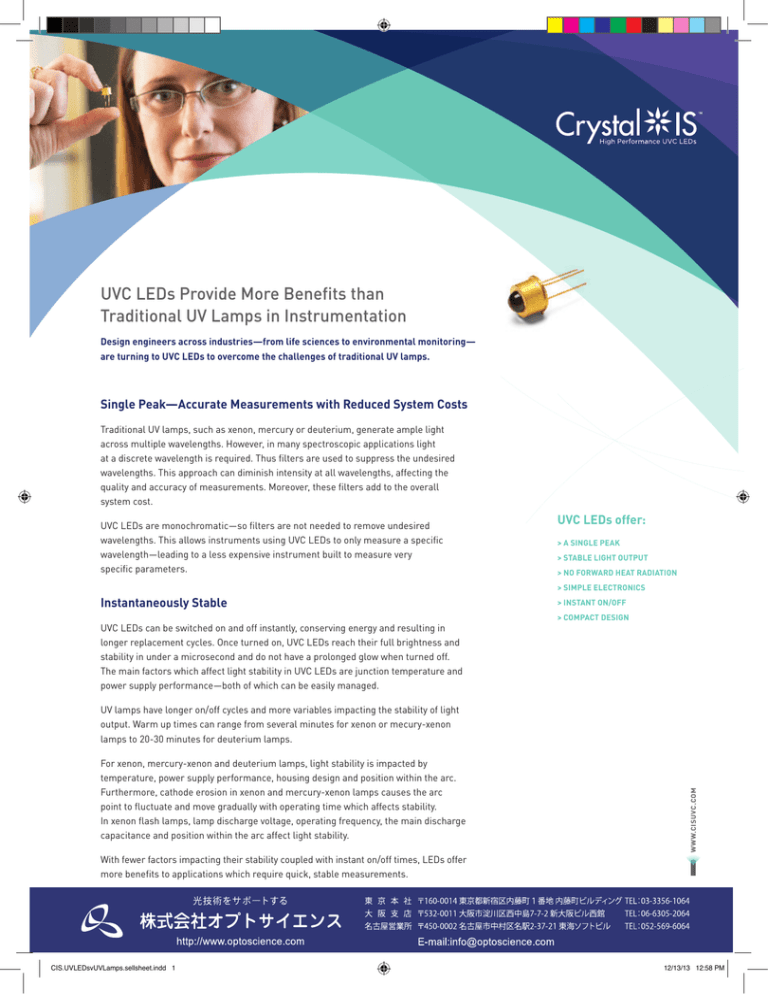
UVC LEDs Provide More Benefits than
Traditional UV Lamps in Instrumentation
Design engineers across industries—from life sciences to environmental monitoring—
are turning to UVC LEDs to overcome the challenges of traditional UV lamps.
Single Peak—Accurate Measurements with Reduced System Costs
Traditional UV lamps, such as xenon, mercury or deuterium, generate ample light
across multiple wavelengths. However, in many spectroscopic applications light
at a discrete wavelength is required. Thus filters are used to suppress the undesired
wavelengths. This approach can diminish intensity at all wavelengths, affecting the
quality and accuracy of measurements. Moreover, these filters add to the overall
system cost.
UVC LEDs are monochromatic—so filters are not needed to remove undesired
wavelengths. This allows instruments using UVC LEDs to only measure a specific
wavelength—leading to a less expensive instrument built to measure very
specific parameters.
UVC LEDs offer:
> A SINGLE PEAK
> STABLE LIGHT OUTPUT
> NO FORWARD HEAT RADIATION
> SIMPLE ELECTRONICS
Instantaneously Stable
UVC LEDs can be switched on and off instantly, conserving energy and resulting in
longer replacement cycles. Once turned on, UVC LEDs reach their full brightness and
stability in under a microsecond and do not have a prolonged glow when turned off.
The main factors which affect light stability in UVC LEDs are junction temperature and
power supply performance—both of which can be easily managed.
> INSTANT ON/OFF
> COMPACT DESIGN
For xenon, mercury-xenon and deuterium lamps, light stability is impacted by
temperature, power supply performance, housing design and position within the arc.
Furthermore, cathode erosion in xenon and mercury-xenon lamps causes the arc
point to fluctuate and move gradually with operating time which affects stability.
In xenon flash lamps, lamp discharge voltage, operating frequency, the main discharge
capacitance and position within the arc affect light stability.
WWW.CISUVC.COM
UV lamps have longer on/off cycles and more variables impacting the stability of light
output. Warm up times can range from several minutes for xenon or mecury-xenon
lamps to 20-30 minutes for deuterium lamps.
With fewer factors impacting their stability coupled with instant on/off times, LEDs offer
more benefits to applications which require quick, stable measurements.
CIS.UVLEDsvUVLamps.sellsheet.indd 1
12/13/13 12:58 PM
Heat Leaves the Back—Not the Front
Conventional UV lamps radiate forward heat, which can damage or interfere with heatsensitive samples and affect measurement outcomes. Also, forward heat radiation in
arc-based lamps can damage essential optical filters if heat filters are not also used.
LEDs radiate a minimal amount of heat from the front side. Instead, most of the heat
generated in the chip is extracted out of the backside of the LED through conduction
and/or convection. Thermal management can be accomplished through simple passive
and active cooling techniques, making LEDs the ideal choice for heat sensitive applications.
Simple Electronics—Low Voltage for Safer Operation
LEDs require lower currents and the required drivers are relatively inexpensive, unlike
more traditional light sources. The current driver regulates current through the LED
regardless of variations in power supply or changes in forward voltage. This driver also
ensures that the current does not exceed the maximum current rating of the LED.
In contrast to LEDs, traditional UV light sources require higher voltages to increase light
output and have more complex requirements for power supplies and ancillary electronics.
This has implications for safety, cost, thermal management and ease of operation.
COM PA R I SO N O F LEDs WI T H T RADI T I O NAL L AM PS
LED
Deuterium lamp
Xenon flash lamp
Mercury Lamp
Spectrum Single Peak
Broad spectrum
Broad spectrum
Broad spectrum
Stability of Light Output
Excellent
Good Relatively Poor
Relatively Poor
Warm Up Time
Instantaneous
20-30 minutes
Instantaneous
1-15 minutes
Thermal Effect None*
on Samples
Heat sensitive
None
samples can be
affected
Heat sensitive
samples can be
affected
Overall Cost of Ownership
Low**
High
High
Low
Drive Electronics
Simple
Complex
Complex
Complex
Safety
Low voltage, cold Hot bulb surface
High voltage
High voltage
light source with
with high voltage supply with
supply and
shock resistant power supply
ignition and
contains mercury
construction
sparking risk
in fragile quartz
envelope
* LEDs do not emit forward heat
** Lowered cost of ownership due to cost savings on power supply and housing, and lack of filters required
UVC LEDs are paving the way for new applications and product designs. With Crystal IS,
design engineers can leverage these benefits for new product innovations.
We invite you to learn more about our UVC LEDs.
70 Cohoes Avenue
www.cisuvc.com
Green Island, NY 12183
518.271.7375
U.S.A.sales@cisuvc.com
©2014 Crystal IS, Inc. All rights reserved. Crystal IS and the Crystal IS logo are trademarks of Crystal IS, Inc.
and/or its affiliates. All other trademarks are the property of their respective owners. 1011-1312
CIS.UVLEDsvUVLamps.sellsheet.indd 2
12/13/13 12:58 PM




